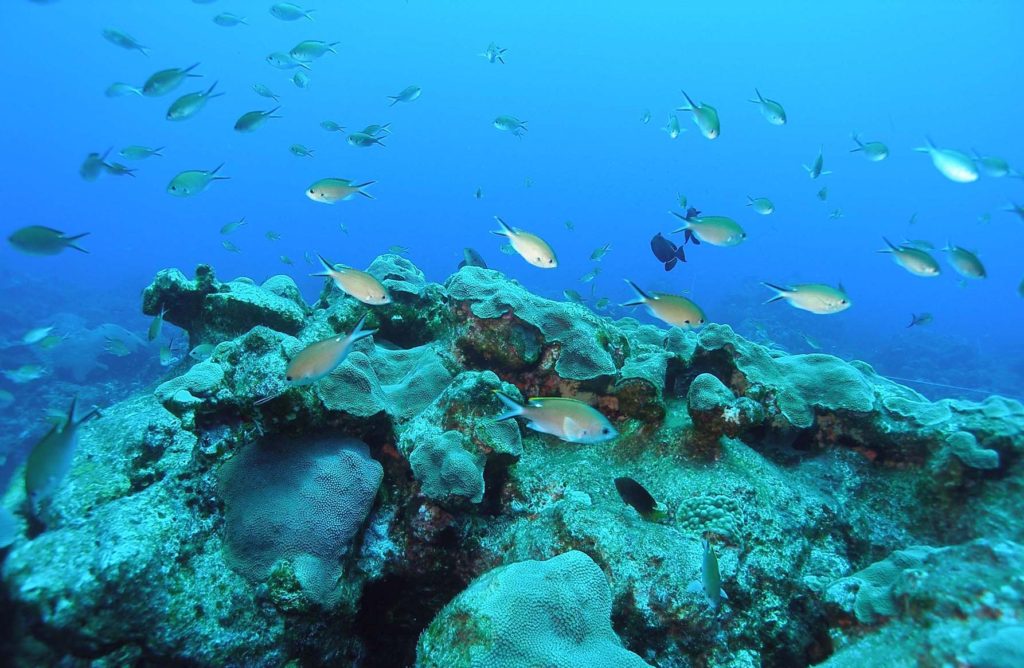by Kristen Minogue
The ocean is losing its breath. Two years ago, an international team of scientists known as GO2NE (the Global Ocean Oxygen Network) published a report in Science with a stark picture of oxygen loss in Earth’s waters: In the open ocean, the amount of water with zero oxygen has spiked fourfold since the mid-20th century. In coastal water bodies, places with dangerously low oxygen (2 milligrams per liter or less) have increased more than 10-fold. It’s a problem not just for animals, but for people and economies—especially those that rely on tourism or subsistence fishing.
On Dec. 7, a new report emerged from the International Union for the Conservation of Nature. The ocean could lose 3-4% of its total oxygen by the end of the century if nothing changes, with losses even higher in the top, biodiversity-rich 1,000 meters. Large fish like tuna, sharks and marlin are among the most vulnerable. In the closing chapter, led by Denise Breitburg of the Smithsonian Environmental Research Center, they created a massive blueprint for resuscitating the ocean.
We’ve pulled out the highlights below, but the key lies in cracking two global conundrums—nutrient pollution and climate change. Nutrient pollution happens when chemicals like nitrogen and phosphorus stream into the water and fertilize massive growths of algae, which suck oxygen out of the water. Climate change’s role is more subtle, but just as powerful: Warmer water can’t hold as much dissolved oxygen. Warm water also doesn’t mix as well, so oxygen from the atmosphere that’s abundant near the ocean surface doesn’t reach everywhere that needs it.
Fortunately, these two problems are linked. Cleaning up nutrient pollution can help solve climate change, and vice-versa—and the ocean will breathe easier for it. Here are eight highlights from the new report:
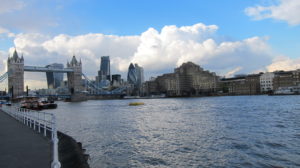
In the 1960s, the Thames River went from zero oxygen to over 10% saturation, largely thanks to changing how managers treated wastewater. (Credit: Carlos Cunha. Creative Commons License)
1. Treat wastewater to get rid of nitrogen and phosphorus. Cleaning up sewage isn’t glamorous, but it works. Ask the residents of Great Britain, who saw oxygen in the Thames River bounce back in the 1960s and 1970s, when they treated their wastewater to remove both chemicals. A 10-fold increase in the number of species in the river followed. Or ask the Finns, who witnessed their own recovery in Finland’s Laajalahti Bay after getting nitrogen and phosphorus in their wastewater down to near zero. Cities are hot spots for nutrient pollution. Making the copious waste they generate a little cleaner can go a long way.
2. Make farming more efficient. Agriculture is another major source of nutrient pollution. Much of it comes from fertilizers, whose main purpose is to saturate crops with nitrogen and phosphorus to help them grow. But many crops receive far more fertilizer than they could ever absorb. The excess flows into water bodies to create oxygen-sucking algal blooms. Setting reasonable limits on the amount of nutrients plants can receive—while ensuring they still get what they need—could save farmers money and help save the ocean. Better farming practices could also help solve climate change: Agriculture is now responsible for over 10% of the greenhouse gas emissions humans emit worldwide.
3. Capitalize on forests and wetlands. It’s one of the most widely-touted climate change solutions. Plant them, preserve them, restore them; forests and wetlands are indispensable for their power to pull carbon out of the atmosphere. But in the right places, they can also combat nutrient pollution. Both ecosystems act like sponges, soaking up excess nitrogen and phosphorus from the land to fertilize their own plants. When planted beside a stream, they can absorb nutrient pollution before it enters the water.
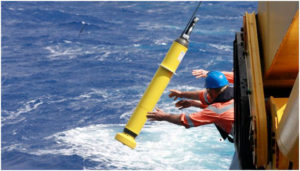
Researchers deploy an Argo float in the Indian Ocean. As of July 2019, the Argo Float Programme had 353 floats around the world collecting data on oxygen in the water. (Credit: Alicia Navidad/CSIRO)
4. Deploy real-time monitoring networks. Nothing beats having eyes on the ground—even if those eyes are hundreds of sensors drifting in the water. The Argo Float Programme has nearly 4,000 floats in open ocean waters around the world. Roughly 300 of those floats are equipped with oxygen sensors that take data every 10 days. Monitoring networks can help detect low-oxygen events in the ocean when they occur, enabling governments to respond quickly. They can also detect patterns over time and space, making it easier to predict when seasonal low-oxygen events in the ocean will occur and how long they will last.
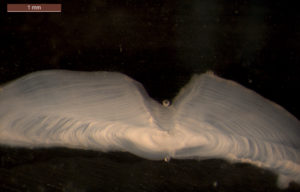
Otolith or “ear stone” of a black rockfish. Scientists are attempting to read otolith rings like tree rings, recording info on the chemistry and oxygen levels a fish experiences over its life. (Credit: Vanessa von Beila/USGS)
5. Use fish as “mobile monitors.” Fish have small, calcified growths called otoliths in their ears. As they grow, they record the chemistry of the water as the fish swims through it. Scientists are just now starting to read these otoliths like tree rings, attempting to trace when and where in their lives fish have passed through low-oxygen waters.
6. Act globally and locally. When an issue impacts the entire world—be it climate change, low oxygen or plastic pollution—international networks are critical for understanding the full scope. The GO2NE team was the first such network to put oxygen loss in Earth’s waters at the forefront of its mission. Global groups can shape policy as well: When the United Nations crafted its plans to combat climate change, it relied heavily on reports from the Intergovernmental Panel on Climate Change.
But it’s important not to overlook local and regional work. That’s where leaders make decisions about environmental restoration and green infrastructure. It’s also where initiatives like city climate action plans and carbon cap and trade get tested in the field. If these programs succeed—and often even if they fail—they provide invaluable lessons for communities elsewhere.
7. Look at the whole ecosystem. When oxygen plummets, it can reverberate through the entire marine food web. But for decades, governments have set fishing rules that treat each species separately, like an island–crabs, oysters, salmon, tuna. That’s starting to change. Managers are starting to embrace a more “ecosystem-based” approach that looks at how everything in an ecosystem connects. For low oxygen, this could mean setting size limits to protect species that are vulnerable when they’re young and small. Or, it could mean avoiding fishing in certain places or seasons when animals are most threatened by low oxygen.
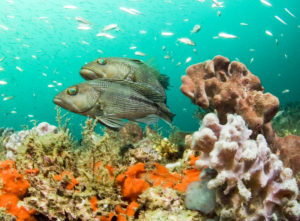
Sea bass inside Gray’s Reef National Marine Sanctuary in Savannah, Georgia. (Credit: Greg McFall/NOAA)
8. Create marine protected areas with flexible boundaries. Marine protected areas work. Study after study has shown they’re among the most successful programs for helping fish populations rebound, increasing catch for fishers outside protected areas, and helping fisheries remain strong and healthy in the face of climate change. Crafting plans that account for low oxygen could make them even more resilient. Many low-oxygen events are seasonal, especially on the coast where most of the world’s fishing takes place. Flexible boundaries would help protect animals when and where they’re most vulnerable, while still allowing fishers to make a living.
For years the ocean’s struggle to hold onto its oxygen has gone largely unnoticed. It’s been drowned out by other threats the ocean faces, such as acidification and plastic pollution. But the good news, as the new report points out, is that we don’t need to solve every challenge separately. One set of solutions can solve a multitude of threats—including threats to developing nations and their economies, where many people don’t have the luxury of moving away when resources dry up.
Even more encouraging: Most of these solutions are in place somewhere in the world. The challenge now is scaling them up. The report doesn’t promise the road will be smooth. Some will take serious financial commitments. But the payoff is a healthier, more bountiful ocean for decades to come.
The Global Ocean Oxygen Network (GO2NE) is a working group of UNESCO’s Intergovernmental Oceanographic Commission. Created in 2016, its members come from 12 countries and five continents. The GO2NE team is dedicated to providing a global view of oxygen loss in Earth’s open ocean and coastal waters, to better understand its causes and impacts. Learn more at https://en.unesco.org/go2ne.
Read More:
Full IUCN Report – Ocean Deoxygenation: Everyone’s Problem
IUCN Report Chapter 11 – What can we do? Adaptation and solutions to declining ocean oxygen
Smithsonian Magazine: Do Ocean Preserves Actually Work?
The Ocean Is Losing Its Breath. Here’s the Global Scope.

